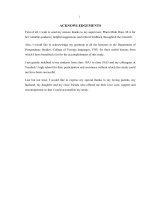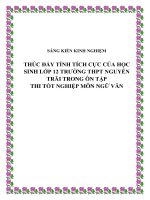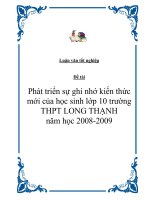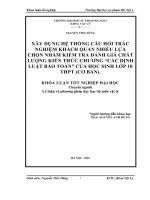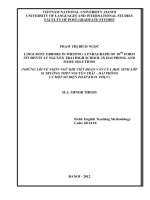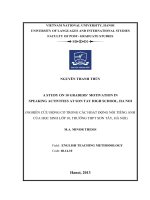Khảo sát các lỗi về dạng thì của động từ thường gặp trong bài viết đoạn văn của học sinh lớp 10 trường thpt kim
Bạn đang xem bản rút gọn của tài liệu. Xem và tải ngay bản đầy đủ của tài liệu tại đây (850.88 KB, 51 trang )
VIETNAM NATIONAL UNIVERSITY, HANOI
UNIVERSITY OF LANGUAGES AND INTERNATIONAL STUDIES
FACULTY OF POST-GRADUATE STUDIES
*************************
ĐẶNG THỊ HOÀNG LAN
AN INVESTIGATION INTO THE ERRORS IN VERB-TENSE
FORMS FOUND IN PARAGRAPH–WRITING BY THE 10th-FORM
STUDENTS AT KIM THANH UPPER-SECONDARY SCHOOL
(Khảo sát các lỗi về dạng thì của động từ thường gặp trong bài viết đoạn
văn của học sinh lớp 10 trường THPT Kim Thành)
M.A. MINOR PROGRAMME THESIS
Field: English Teaching Methodology
Code: 60140111
Hanoi – 2016
VIETNAM NATIONAL UNIVERSITY, HANOI
UNIVERSITY OF LANGUAGES AND INTERNATIONAL STUDIES
FACULTY OF POST-GRADUATE STUDIES
*************************
ĐẶNG THỊ HOÀNG LAN
AN INVESTIGATION INTO THE ERRORS IN VERB-TENSE
FORMS FOUND IN PARAGRAPH–WRITING BY THE 10th-FORM
STUDENTS AT KIM THANH UPPER-SECONDARY SCHOOL
(Khảo sát các lỗi về dạng thì của động từ thường gặp trong bài viết đoạn
văn của học sinh lớp 10 trường THPT Kim Thành)
M.A. MINOR PROGRAMME THESIS
Field: English Teaching Methodology
Code: 60140111
Supervisor: ASSOC.PROF.DR. LÊ VĂN CANH
Hanoi – 2016
DECLARATION OF AUTHORSHIP
I, ĐẶNG THỊ HOÀNG LAN, hereby certify that this thesis, which is
entitled “An Investigation into the Errors in Verb-Tense Forms Found in
Paragraph-Writing by the 10th-Form Students at Kim Thanh UpperSecondary School” is created from my original work. I have firmly declared the
contribution of others to my thesis such as data analysis, practical strategies, and
all other researches that were employed or reviewed in my thesis.
This thesis is the result of my own study in the fulfillment of the
requirement for the Degree of Master of Arts at Faculty of Post-Graduate
Studies, University of Languages and International Studies, Vietnam National
University, Hanoi.
Hanoi, 2016
ĐẶNG THỊ HOÀNG LAN
i
ACKNOWLEDGMENTS
First of all, I wish to express my deepest gratitude to my supervisor, Assoc.
Prof. Dr. Lê Văn Canh, whose insightful comments, criticism, direction and kind
support were of great assistance to me in carrying out this study.
My sincere thanks also go to all the lecturers and staff of the Faculty of
Post- Graduate Studies, Hanoi University of Languages and International
Studies, Vietnam National University, Hanoi, for their valuable knowledge and
invaluable guidance and help during my two years of study at the Faculty.
I am also indebted to my colleagues as well as my students at Kim Thanh
Upper-Secondary School, who have helped me a lot in my data collection to fulfill
this paper.
Last but not least, I would like to express my appreciation to my family
for their understanding and strong encouragement to me throughout the study.
Đặng Thị Hoàng Lan
ii
ABSTRACT
This study aims at investigating the common errors in verb-tense forms
made by the students of grade 10 at Kim Thanh Upper- Secondary School. The
participants are forty two tenth-grade students at Kim Thanh Upper-Secondary
School, where the author is working. In order to find out the most common
errors in verb-tense forms and factors causing the students‟ making these errors,
two data collection instruments are employed: students‟ written paragraphs and
individual open-ended interviews. The results showed that more errors were
made in verb-tense forms than in verb-tense choice. Regarding the errors made
by the students‟ confusion of different verb tenses, the most and the least
erroneous tenses were the Past Simple tense and the Future Simple Tense
respectively. As to errors in verb-tense forms, omission errors were the most
frequent ones, while misordering was the least frequently-made. By describing
and interpreting the data collected, the researcher managed to find out factors
leading to these errors, which consisted of both objective factors and subjective
factors. Based on the literature review and findings, the author put forward
practical suggestions to the teachers of English with a view to improving
English teaching and learning at the school.
iii
TABLE OF CONTENTS
DECLARATION OF AUTHORSHIP ......................................................................i
ACKNOWLEDGEMENTS .................................................................................... ii
ABSTRACT ........................................................................................................... iii
TABLE OF CONTENTS ........................................................................................iv
LIST OF TABLES .................................................................................................vi
LIST OF ABBREVIATIONS ............................................................................... vii
PART A: INTRODUCTION ................................................................................. 1
1. Rationale of the study ........................................................................................... 1
2. Objectives of the study ......................................................................................... 2
3. Research question ................................................................................................. 2
4. Scope of the study ................................................................................................ 2
5. Method of study ……………………………………………….………………..2
6. Design of the study ............................................................................................... 3
7. Significance of the study ...................................................................................... 3
PART B: DEVELOPMENT .................................................................................. 5
CHAPTER 1: LITERATURE REVIEW ............................................................. 5
1.1. The writing syllabus for 10th-grade students .................................................... 5
1.2. Definitions of errors .......................................................................................... 6
1.3. Causes of errors ................................................................................................. 6
1.4. The challenges of learning English verb tenses ................................................ 8
1.5. Theoretical Foundation of Error Analysis …………………….…………….12
1.5.1. Interlanguage Theory…………………………………………….…………12
1.5.2.Interference of First language (L1) into Second Language (L2)…………..14
1.6. Methods used in researching errors………………………………………….15
1.6.1. S.P Corder‟s Error Analysis Procedure………………………….………..15
1.6.2. Surface Strategy Taxonomy (Dulay, Burt and Krahsen, 1982) ….………..16
CHAPTER 2. RESEARCH METHODOLOGY .......................................... ..19
iv
2.1. Research design and methodology .............................................................. …19
2.2. Participants ...................................................................................................... 20
2.3. Data Collection Instruments ............................................................................ 20
2.4. Research Procedures........................................................................................ 21
CHAPTER 3: DATA ANALYSIS AND DISCUSSION……………………...23
3.1. Common verb-tense errors made by the 10th-form students ....................... 23
at Kim Thanh Upper-Secondary School ............................................................... 23
3.1.1. Wrong choice of verb tenses ........................................................................ 23
3.1.2. Wrong formation of verb tenses ................................................................... 27
3.1.2.1. Errors of omission ..................................................................................... 27
3.1.2.2. Errors of addition....................................................................................... 29
3.1.2.3. Errors of misformation .............................................................................. 30
3.1.2.4. Errors of misordering ............................................................................... 31
3.2. Factors that lead to the errors in verb-tense forms in paragraph writing made
by the 10th-form students at Kim Thanh................................................................ 32
Upper-Secondary School ....................................................................................... 32
3.3. Discussion of the findings .............................................................................. 35
PART C: CONCLUSION .................................................................................... 36
1. Conclusion .......................................................................................................... 36
2. Implications……………………………………………………………………36
3. Limitations and suggestions for further study ....................................................37
3.1. Limitations of the study .................................................................................. 37
3.2. Suggestions for further research ..................................................................... 37
REFERENCES ..................................................................................................... 39
APPENDICES……………………………………………………………………I
APPENDIX A: Questions for interview
APPENDIX B: Photocopies of some students‟ writing pieces
v
LIST OF TABLES
TABLES
Table 1.1
Page
Fossilization Process of Interlanguage (adapted from
13
Selinker 1972)
Table 1.2
Positive and Negative Transfer (Adapted from Khansir, 14
2012)
Table 1.3
Error Analysis Procedure by S.P Corder
15
Table 3.1
An overview of the errors in verb tense choice
24
Table 3.2
Omission Errors
27
Table 3.3
Addition Errors
29
Table 3.4
Misformation errors
30
Table 3.5
Misordering errors
31
Table 3.6
Summary of the errors in verb-tense forms
31
Table 3.7
Factors leading to the errors
33
vi
LIST OF ABBREVIATIONS
BA: Bachelor of Arts
M.A: Master of Arts
EFL: English as a Foreign Language
L1: First language, or Mother tongue.
L2: Second language
vii
PART A: INTRODUCTION
1. Rationale of the study
In English, the different tenses are signaled by verb endings or by auxiliary
verbs. The English tense system is quite complicated. Therefore, it is not
surprising that even though students start from the easiest tense, they find it
difficult to understand, remember and use the tense correctly, especially when,
besides various uses and forms of different verb tenses, they have to memorize all
kinds of nouns, verbs, adjectives, adverbs and auxiliaries. This will make
students bored and make it difficult for them to comprehend English grammar.
In English writing, verb is the most active part in the sentence for
expressing an action, an occurrence, or a state of being. Palmer (1965: 5)
suggests that “learning a language is to a very large degree learning how to
operate the verbal forms of that language.” In English, verbs are inflected for
tense while there is no inflection in Vietnamese. This causes difficulty to
Vietnamese students learning English.
Through this study, the author tries to find out the common types of errors
in using verb-tense forms made by the 10th- grade students at Kim Thanh UpperSecondary School in their written paragraphs.
As a teacher at Kim Thanh High School, a school in a rural area of Hai
Duong province, the author sees that students tend to have problems in using the
English tenses in their writings. The situation encourages the author to have An
Investigation into the Errors in Verb-Tense Forms Found in ParagraphWriting by the 10th-Form Students at Kim Thanh Upper-Secondary School.
It is hoped that the results of this study will be useful for both teachers and
students in teaching and learning writing skill in general and in improving
paragraph-writing ability in particular.
2. Objectives of the study
The main objective of this study is to analyze students‟ errors in using
English tenses and identify the sources of errors as taken from the students‟
writings as well as to provide some pedagogical implications for teaching English
as a foreign language. The objectives of this study are:
1
1. To describe the types of errors in verb-tense forms made by the 10th- grade
students at Kim Thanh Upper-Secondary School as revealed in their writings.
2. To describe the causes of errors in verb-tense forms.
This study is carried out in the hope that teachers and students can define
the student‟s common errors in verb-tense forms and adjust their way of teaching
and learning this skill basing on the causes of these errors in order to obtain better
results.
3. Research Questions
In order to achieve the above aims, two research questions are raised:
1. What are the common verb-tense errors made by the 10th-form students at Kim
Thanh Upper-Secondary School?
2. What are the causes of these errors according to the students’ self-reports?
4. Scope of the Study
Due to the limited time and restricted scope of study of a minor thesis, this
study only focuses on identifying a number of common errors in verb-tense
forms committed by 10th-form students at Kim Thanh High School when they
write paragraphs. Based on the discussions of the findings, some possible
solutions will be introduced.
5. Method of the study
In this study, the writer adopted mainly quantitative and qualitative
research methods. Two main instruments were employed for data collection:
students‟ written paragraphs and interviews.
Specifically, 168 paragraphs, each of which is about 130-150 words in
length, on four different topics were collected from 42 students of grade 10.
Errors on verb tense forms were identified and classified into different categories.
Statistical counting was carried out to present the real picture of students' errors
on verb tense forms.
A face-to-face interview with individual students was conducted to find
out the reasons students gave for the way they used the verb-tense forms in their
written paragraphs.
2
6. Design of the thesis
The study consists of three parts, organized as follows:
Part A – Introduction - gives basic information about the topic of this paper
including the reason for choosing the topic, objectives, research questions, scope,
method and significance of the study. An outline of the thesis is also mentioned
in this chapter.
Part B - Development
This part is composed of three chapters.
Chapter 1- Literature Review - discusses the relevant theories related to errors,
causes of errors, challenges of learning English verb tenses as well as theoretical
foundation of error analysis.
Chapter 2- Research Methodology - mentions the methodology employed to
carry out the research. This includes a discussion of the participants, the setting,
the data collection instruments, data collection procedure and data analysis.
Chapter 3- Data Analysis and Discussion - presents the findings and discussion
of the findings.
Part C- Conclusion- provides some practical suggestions to help teachers have
effective methods in teaching writing skill. Some brief information about the
limitations of the study and suggestions for further study will also be included.
7. Significance of the study
The study is significant for a variety of reasons. From an academic level it
allows for a highly useful demonstration regarding the learning and language
skill abilities of students within the specified tenth grade class. This is important
to assess the way that grammatical errors may occur as well as the way that they
can be propagated despite instructors‟ efforts.
The students‟ errors that are identified in this investigation are particular to
those within a rural learning setting. The specific nature of their errors will allow
for a differentiated understanding of the way that future evaluation regarding
verb formation can be improved. Such a value is further important based on the
responses from a qualitative survey (the interview) regarding the student
3
perspective on teaching style and their own aptitude for retention. The study
would further be significant in detailing the way that rural students at the tenth
grade level form cognitive application of the English language as well as the
common themes or challenges in teaching this demographic. The overall
significance of individual case reports within this area will create a highly
valuable account of one particular community in Vietnam and can be seen as
useful for gathering conclusions about other areas as well.
Ultimately the value of this inquiry will promote second language learning
skill acquisition research on a whole. There are specific benefits towards the
parallels between those learning English with their mother tongue being
Vietnamese in particular. The greatest value that can be identified would be the
connection between information from this micro study with the larger picture of
research on the learning and teaching of English in similar contexts.
4
PART B: DEVELOPMENT
CHAPTER 1: LITERATURE REVIEW
1.1. The writing syllabus for 10th - grade students
Unit
Writing Task
1
Writing a narrative
2
Filling in a form
3
Writing about people‟s background
4
Writing a letter of complaint
5
Writing instructions
6
Writing a confirmation letter
7
Writing about the advantages and disadvantages of the mass media
8
Giving direction
9
Interpreting facts and figures
10
Writing an informal letter of invitation
11
Writing an informal letter of acceptance or refusal
12
Writing a profile
13
Describing a film
14
Writing an announcement
15
Describing a friend
16
Describing a chart
5
1.2. Definitions of errors
Making errors is the most natural thing in the world. In communication,
both native speakers and non-native speakers can make errors though their errors
are different.
Error is defined as “systematic deviations” from the norms of language
being learnt by Cunning Worth (1987) or when a learner has not learnt something
and constantly gets it wrong. Besides, Choon (1993) describes “error” as a form
of structure that is inappropriately used and that cannot be accepted by a native
speaker. According to Richards (1989), the term is identified as a faulty use of a
linguistic item which shows incomplete learning. Another definition of errors is
given by Brown (1994). He identifies errors as “noticeable deviation from the
adult grammar of a native speaker, reflecting the interlanguage competence of
the learner”. Corder (1973) refers to errors as breaches of the code; they deviate
from what is regarded as the norm by native speakers.
Error in writing is defined by many linguists and methodologists, but in
short it is the faulty use of target language and it reveals a portion of the learners‟
weak competence in the target language.
Error analysis
Error analysis is a valuable source of information to teachers. It provides
information on learner‟s error which helps teachers to correct it and also
improves the effectiveness of their teaching. In other words, errors give signs to
teachers and researchers whether the using process is successful or not (Brown,
1994).
1.3. Causes of Errors
Furthermore, Richards then subdivides the intralingual or developmental
errors as the causes of errors into:
• Overgeneralization
According
to
Jacobvist
quoted
by
Richards
(1971:
174),
overgeneralization or transfer is the use of previously available strategies in new
situations. In second language learning some of these strategies will prove helpful
in organizing the facts about the second language, but others, perhaps due to
6
superficial similarities, will be misleading and inapplicable - overgeneralization
covers instances where the learner creates a deviant structure on the basis of his
experience of other structures in the target language.
Based on the above statements, we can say that the cause of error in this
case is not the influence of the learners' mother tongue but it is the influence of
the target language which they have already learnt, for example: “He runs
fastly”. In this sentence, the learner produces an error because he/she generalizes
that adverbs of manner must always be formed by adding 'ly' to the adjectives.
• Ignorance of Rule Restriction
This kind of error is closely related to overgeneralization; that is, the
learners fail to observe the restrictions of certain structures. In this case, they
apply a rule in the context of a sentence where actually it is not necessary, e. g :
The man whom I saw him yesterday. The student does not know that it is
impossible to mention the person referred to by the relative pronoun by another
pronoun as well.
• Incomplete Application of Rule
This means that the learners apply a rule in the context of a sentence,
although the rule is not yet complete. The students may use a statement for a
question by adding a question mark at the end of the sentence, for example: “He
goes to school?”
• False Concepts Hypothesized
False concepts hypothesized refers to faulty rule learning at various levels.
There is a class of interlingual errors which derive from faulty comprehension of
distinctions in the target language. These are sometimes due to poor gradation of
teaching items some students get confused and cannot differentiate between go
and come, bring and take, too and very, etc. They use the present tense instead of
the present continuous tense or the other way round. This might be caused by
learners not paying much attention to the difference between items. They
consider too and very are the same as well as go and come, etc.
Another cause of error mentioned by George (1972) is 'redundancy
reduction'. This is a tendency by EFL learners to eliminate many items or add
7
unnecessary items which are redundant to conveying the intended message. For
instance, in the case of a learner of English language as a foreign language we
may meet utterances, such as: “No understand”, “return back” etc. It is rather a
simplified code of communication or reduced language systems used by foreign
language learners especially in earlier stages of the learning process.
1.4. The challenges of learning English verb tenses
Verbs in English provide information about whether they are happening in
the past, present and future. Hence, in English, tense is marked on all verb forms.
EFL learners face several difficulties in their attempt to master English tense
properly. For Cowan (2008, p. 350) “use of verb forms is one of the two or three
most difficult areas for English language learners to master.” As a result, EFL
learners sometimes make mistakes in the proper use of verb forms as they
attempt to express the time of an event in the target language.
The following sentences were produced by some Bengali learners of
English who have completed secondary education (Cowan, 2008). The sentences
indicate some potential areas in which they are likely to make errors:
(1) * When I was entered into the exam hall, I was feeling nervous.
(When I entered the exam hall, I was feeling nervous.)
(2) * I was seen and introduced with many unknown students.
(I saw many unknown students, and I was introduced to them.)
(3) * Then I was taken lunch.
(Then I took lunch.)
(4) * Then I was come back home.
(Then I came back home.)
(5) * I was done the work.
(I did the work.)
The above Bengali learners of English seem to make errors in the
formation of past expression;
Sentences 1 to 5, for example, indicate that some EFL learners form past
tense using an auxiliary and the past participle form of the verbs instead of using
the past form of the verbs.
8
Therefore, this is an area in which learners are observed to face problems
in using verbs to indicate past time.
EFL learners are sometimes found to form expression in which time itself
is confused. In the following example (6), a student does not use any auxiliary to
indicate whether the action time is in the present or the past. This may be due to
the L1 interference because in Bengali language, progressive action does not
require any extra auxiliary.
(6) * I going with my father.
(I am/was going with my father.)
In example 7, an EFL learner who is studying for a BA degree in English,
uses “is appeared‟ to form the following past expression:
(7) * The ghost is appeared for some reasons.
(The ghost appeared for some reasons.)
EFL learners‟ native language (L1) influence can be claimed to be one of
the reasons behind their failure to acquire the tense of the target language (TL).
For example, according to Cowan (2008), in some languages, including Chinese,
tense is not expressed through „overt markers, or inflections on verbs‟. The
following Chinese sentences, for example, indicate past time with the use of „jien
tien‟ not by adding an inflection such as the „English –ed‟.
(8)„Ta zao tian chu zhigiageo‟
(*She yesterday go Chicago.)
(She went to Chicago yesterday)
Apart from the Chinese EFL learners, L1 influence is observed among the
Dutch learners of English.
According to Housen (2000), Dutch EFL learners are required to
understand the difference between the simple past and the past progressive in
English as this dissimilarity is not marked in their L1. L1 influence may retain to
affect even the proficient L2 learners (See also, Housen, 2002).
Unlike English, Bengali speakers do not need to use inflection in the verb
for simple present tense.
(9) Arif vat khai
9
*Arif eat rice.
(Arif eats rice.)
Sentence 9, for example, shows that the Bengali EFL learner of English
did not use inflection in the verb -eat. This is a common mistake that is observed
with most EFL learners in Bangladesh, and this seems to happen since Bengali
language does not indicate present tense though inflection on verbs.
According to Cowan (2008), unlike English, some languages do not
include „back shifting constraints‟ (p.382). Bengali speakers may use their L1
sequence of tense rule in forming English sentences. For example, in the sentence
shown below (10), the verb in that clause is not back shifted to “had”.
(10) *He remembered that he has to go back home.
(He remembered that he had to go back home.)
Within Bengali language, speakers do not have to maintain tense sequence
by backshifting to previous clause(s).
Hence, some learners apply their Bengali tense sequence in order to form
English sentences with that complements (See also, Cowan, 2008)
Apart from EFL learners‟ problems in tense, sometimes they also have
problems in understanding how they need to see an event-aspect.
In what follow are some example sentences produced by some Bengali
learners of English. The examples indicate the nature of the problems these EFL
learners have in using aspect properly.
(11) * I am reading every day in the evening.
(I read every day in the evening.)
Although „every day’ in sentence 11 indicates that the action is habitual,
hence simple in aspect, the Grade 8 level Bengali learner of English views it as
temporal and therefore progressive in aspect. Here the learner overgeneralizes the
fact that as she reads every day, the action is in progressive aspect. This
phenomenon can be related to the example that is provided by Cowan (2008) that
German simple sentence conforms to both English present simple and present
progressive; hence, „they [German speakers of English] have troubles using the
two English tenses in the appropriate context. A common error is to
10
overgeneralize the progressive to context in which time expression requires a
simple form‟.
For example,
(12) Do you know Sapsucker Woods?
*Yes, my wife is often going there with the children.
Alternatively, German speakers may make errors using simple present in
the place of present progressive (Cowan,2008).
For example, (13)* I send you the money now.
Therefore, the answer to the sentence 12 and sentence 13 are erroneous in
aspect, and the problem in how the German speakers view the action here is
caused by their German L1 interference.
The following ill-formed sentence (14) was produced by a Bengali learner of
English:
(14) * I am studying English for twelve years.
(I have been studying English for twelve years.)
Bengali EFL learners are often seen to produce sentences like (14). This
occurs as within Bengali language temporal progressive aspect (e.g. I am playing
football) is not usually distinguished from the progressive activity that started in
the past but extends to the present (I have been playing football for seven years).
For Vietnamese learners, according to Phap Dam in “Analyzing Some
Persistent Errors in English Made by Vietnamese Speakers”, when necessary,
Vietnamese grammar can express time adequately by means of placing one of
several aspect-marking particles in front of the main verb, notably “đã” (for past),
“đang” (for present), and “sẽ” (for future):
“Hắn đã gặp một bạn cũ tuần rồi.”
[He past-marker meet one friend old week just past]
“He met an old friend last week.”
“Ông thầy đang dạy ngữ pháp tiếng Việt.”
[Mr. teacher present-marker teach syntax language Viet]
“The teacher is teaching Vietnamese syntax.”
“Khi có thì giờ tôi sẽ thăm bác tôi tại Houston.”
11
[When have time I future-marker visit father‟s older brother my in Houston]
“When I am free, I will visit my uncle in Houston.”
With their native tongue lacking the intricate structure of tenses and moods
found in English and other Western languages, Vietnamese speakers find English
tenses other than present (“He IS at work today”), past (“Mary LOOKED so
happy with her parents last week”), and future (“They WILL DO it for us this
afternoon”) hard to understand and use. Indeed, the handling of more
complicated English tenses (especially those expressed by auxiliaries and past
and present participles, like “We WILL HAVE BEEN LIVING in America for
twenty years by then” and “If my parents HAD BEEN rich at that time, they
WOULD HAVE SENT me to a private school in Switzerland”) could qualify as
the problem area in which they make the most errors. The serious mismatch in
tense and mood systems between Vietnamese and English and the convenient
simplicity of the Vietnamese system are the reason why Vietnamese learners of
English keep writing such interference-induced sentences as:
# “We live in California since 1975.”
# “ I really wish I can speak English like you.”
# “ If you are ten years younger, my brother will probably marry you.”
It is worth noting that the above sentences reflect “correct” Vietnamese
syntax, and that some Vietnamese learners of English deliberately avoid using
complicated tenses in English, simply for fear of making mistakes.
1.5. Theoretical Foundation of Error Analysis
1.5.1 Interlanguage Theory
According to the Second Language Acquisition theory, learners build up a
system for themselves which is different in some ways from their first language
and second language systems, which are called Interlanguage. The concept of
Interlanguage , which was formerly suggested by Selinker in 1972, aimed to draw
learner‟s attention to the possibility that while learning the second language, a
learner may develop separate internalized mental grammar that is characterized
12
as distinct language variety or system with its own particular characteristics and
rules differs from both his/her mother tongue and the target language.
Interlanguage is typically characterized by the set of linguistic rules which
can further generate novel utterances, and according to Ellis (1990), it is very
important in providing the explanation for “how both children and adults acquire
a second language” (Ellis, 1990). Interlanguage productions typically have the
characteristic of language that hardly conform to the general expectation on what
native speakers of the target language usually produce, not a fixed translation of
native language utterances, spoken utterances are not randomly produced and
interlanguage is usually spoken either by adults or by children when second
language acquisition is not simultaneous acquired with the first language.
Selinker in 1972 further explored the Interlanguage impact on the second
language learning and proposed the five fossilization processes that indicated the
learner‟s tendency to stop developing their interlanguage grammar in the
direction of the target language. The five fossilization processes are as follow:
Table 1.1: Fossilization Process of Interlanguage (adapted from Selinker 1972)
Fossilization Process
Language Transfer
Criteria
Sometimes
rules
and
subsystems
of
the
Interlanguage may result from transfer from the first
language.
Transfer of Training
Some elements of the Interlanguage may result from
specific features of the training process used to
teach the second language.
Strategies
of
Second Some elements of the Interlanguage may result from
Language Learning
Strategies
of
a specific approach to the material to be learned.
Second Some elements of the Interlanguage may result from
Language Communication
specific ways people learn to communicate with
native speakers of the target language.
13
Overgeneralization of the Some elements of the Interlanguage may be the
Target
Language product of overgeneralization of the rules and
Linguistic Materials
semantic features of the target language.
1.5.2. Interference of First language (L1) into Second Language (L2)
Behaviorist learning theory asserts that “old habits contribute in the way of
learning new habits” and thus if taken into context, individuals who learn many
languages tend to transfer the realization device from his first language into the
second language prior to the cognitive notion that the first and second language
share a similar meaning but failed to discern that it should be expressed in
different ways (Ellis, 1990). Smooth acquisition of the second language is often
interfered by the first language grammar which has already been programmed
inside one‟s individual mind prior to the learning process.
There are two types of transfer between mother tongue and target language
which served as the reasons that explained errors made by the learners in both
written and oral construction. They are negative transfer and positive transfer
(Khansir, 2012).
Table 1.2: Positive and Negative Transfer (Adapted from Khansir, 2012)
Type of Transfer
Positive Transfer
Explanation
The forms between the mother tongue and the target
language are similar
Negative Transfer
The forms of the target language and those of the
learner's mother tongue are different from each
other
14
1.6. Methods used in researching errors
1.6.1. S.P Corder‟s Error Analysis Procedure
Error Analysis Procedure have been developed by S.P Corder in 1974
commenting on the errors that can be classified through a comparison process
which is similar to the process involved in the contrastive analysis procedures.
Error analysis is considered as a five-stage procedures. The concept is thoroughly
based on the original erroneous utterance and later compared with the constructed
one but exclusively in term of the linguistic categories such as error in
phonology, morphology, syntax and semantics.
The procedures can be summarized in the five-staged procedures as being
illustrated in the figures below:
Table 1.3: Error Analysis Procedure by S.P Corder
Procedure
Stage
1
Choosing
Description
Decide on the size of sample
Decide on the medium of sample taken:
the spoken (orally) or written (writing)
language corpus
Decide the homogeneity of the sample :
background, age, type of education & location
2
There must be a difference between
errors and mistakes
Identifying
error
in
corpus
the
Only occurring errors are identified for
further process/procedure
3
Rather tedious to identify
Every
error
committed
by
the
respondents will be classified in accordance
Classifying
with
grammatical
15
aspects:
phonology,
Error
morphology, syntax and semantics
More focus and emphasis are on
morphological and syntactical aspects of the
English language
4
An attempt is made to identify the
causes of errors :
Explaining
Error
Interlingual errors: errors are caused by
mother tongue interference
Intralingual and developmental errors:
errors occur during the learning process of the
L2 at a stage when the learners have not really
acquired the knowledge
5
Involving assessing the seriousness of
Evaluating
each error
Error
This step is made to make principled
teaching decisions
Error evaluation is necessary only if the
purpose of the error analysis is pedagogic
1.6.2. Surface Strategy Taxonomy (Dulay, Burt and Krashen, 1982)
Surface Strategy Taxanomy proposed by Dulay, Burt and Krashen in 1982
is a taxonomy developed in analyzing errors made by the learners which consists
of several alternatives for error classification as a result of comparative
categorization and communicative effect taxonomy (Dulay, Burt and Krashen,
1982). This taxonomy divides learner errors into four categories, which are
Omission, Addition, Misinformation and Misordering. Classifying errors using
the Surface Strategy Taxonomy is very practical since it can physically highlight
16

